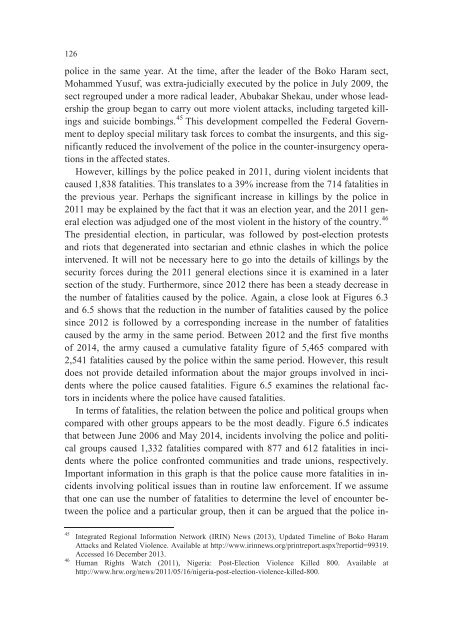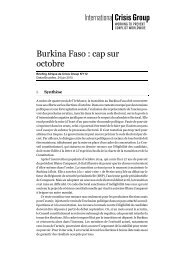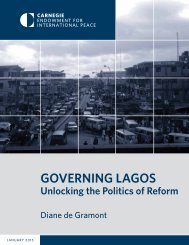Violence in Nigeria
ASC-075287668-3743-01
ASC-075287668-3743-01
You also want an ePaper? Increase the reach of your titles
YUMPU automatically turns print PDFs into web optimized ePapers that Google loves.
126<br />
police <strong>in</strong> the same year. At the time, after the leader of the Boko Haram sect,<br />
Mohammed Yusuf, was extra-judicially executed by the police <strong>in</strong> July 2009, the<br />
sect regrouped under a more radical leader, Abubakar Shekau, under whose leadership<br />
the group began to carry out more violent attacks, <strong>in</strong>clud<strong>in</strong>g targeted kill<strong>in</strong>gs<br />
and suicide bomb<strong>in</strong>gs. 45 This development compelled the Federal Government<br />
to deploy special military task forces to combat the <strong>in</strong>surgents, and this significantly<br />
reduced the <strong>in</strong>volvement of the police <strong>in</strong> the counter-<strong>in</strong>surgency operations<br />
<strong>in</strong> the affected states.<br />
However, kill<strong>in</strong>gs by the police peaked <strong>in</strong> 2011, dur<strong>in</strong>g violent <strong>in</strong>cidents that<br />
caused 1,838 fatalities. This translates to a 39% <strong>in</strong>crease from the 714 fatalities <strong>in</strong><br />
the previous year. Perhaps the significant <strong>in</strong>crease <strong>in</strong> kill<strong>in</strong>gs by the police <strong>in</strong><br />
2011 may be expla<strong>in</strong>ed by the fact that it was an election year, and the 2011 general<br />
election was adjudged one of the most violent <strong>in</strong> the history of the country. 46<br />
The presidential election, <strong>in</strong> particular, was followed by post-election protests<br />
and riots that degenerated <strong>in</strong>to sectarian and ethnic clashes <strong>in</strong> which the police<br />
<strong>in</strong>tervened. It will not be necessary here to go <strong>in</strong>to the details of kill<strong>in</strong>gs by the<br />
security forces dur<strong>in</strong>g the 2011 general elections s<strong>in</strong>ce it is exam<strong>in</strong>ed <strong>in</strong> a later<br />
section of the study. Furthermore, s<strong>in</strong>ce 2012 there has been a steady decrease <strong>in</strong><br />
the number of fatalities caused by the police. Aga<strong>in</strong>, a close look at Figures 6.3<br />
and 6.5 shows that the reduction <strong>in</strong> the number of fatalities caused by the police<br />
s<strong>in</strong>ce 2012 is followed by a correspond<strong>in</strong>g <strong>in</strong>crease <strong>in</strong> the number of fatalities<br />
caused by the army <strong>in</strong> the same period. Between 2012 and the first five months<br />
of 2014, the army caused a cumulative fatality figure of 5,465 compared with<br />
2,541 fatalities caused by the police with<strong>in</strong> the same period. However, this result<br />
does not provide detailed <strong>in</strong>formation about the major groups <strong>in</strong>volved <strong>in</strong> <strong>in</strong>cidents<br />
where the police caused fatalities. Figure 6.5 exam<strong>in</strong>es the relational factors<br />
<strong>in</strong> <strong>in</strong>cidents where the police have caused fatalities.<br />
In terms of fatalities, the relation between the police and political groups when<br />
compared with other groups appears to be the most deadly. Figure 6.5 <strong>in</strong>dicates<br />
that between June 2006 and May 2014, <strong>in</strong>cidents <strong>in</strong>volv<strong>in</strong>g the police and political<br />
groups caused 1,332 fatalities compared with 877 and 612 fatalities <strong>in</strong> <strong>in</strong>cidents<br />
where the police confronted communities and trade unions, respectively.<br />
Important <strong>in</strong>formation <strong>in</strong> this graph is that the police cause more fatalities <strong>in</strong> <strong>in</strong>cidents<br />
<strong>in</strong>volv<strong>in</strong>g political issues than <strong>in</strong> rout<strong>in</strong>e law enforcement. If we assume<br />
that one can use the number of fatalities to determ<strong>in</strong>e the level of encounter between<br />
the police and a particular group, then it can be argued that the police <strong>in</strong>-<br />
45<br />
46<br />
Integrated Regional Information Network (IRIN) News (2013), Updated Timel<strong>in</strong>e of Boko Haram<br />
Attacks and Related <strong>Violence</strong>. Available at http://www.ir<strong>in</strong>news.org/pr<strong>in</strong>treport.aspx?reportid=99319.<br />
Accessed 16 December 2013.<br />
Human Rights Watch (2011), <strong>Nigeria</strong>: Post-Election <strong>Violence</strong> Killed 800. Available at<br />
http://www.hrw.org/news/2011/05/16/nigeria-post-election-violence-killed-800.






